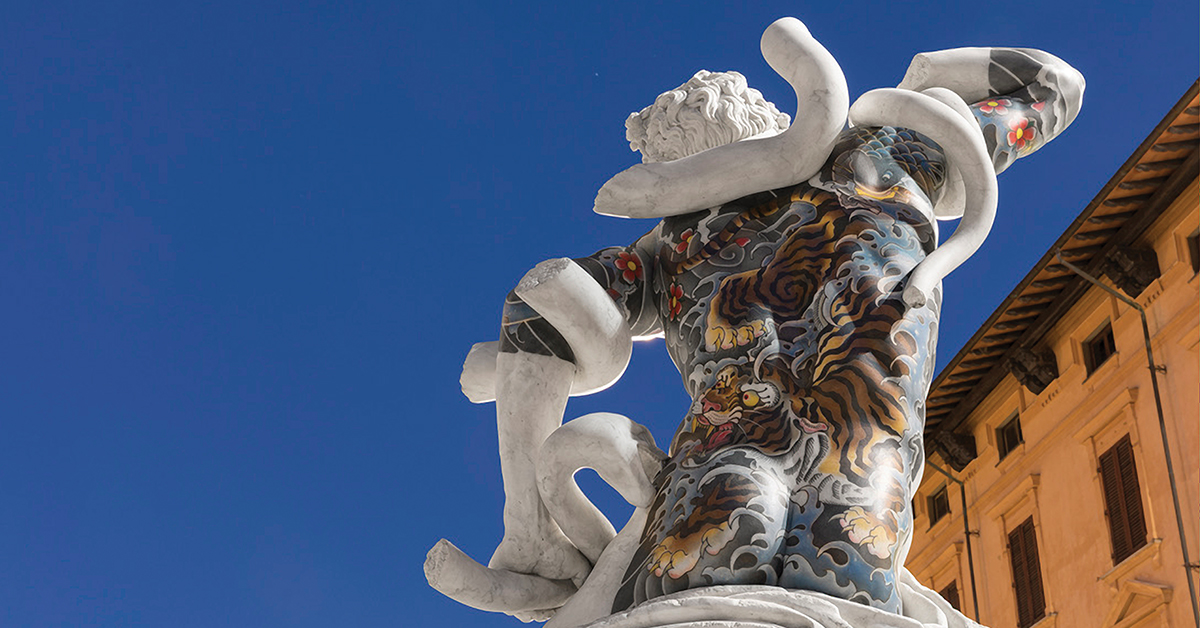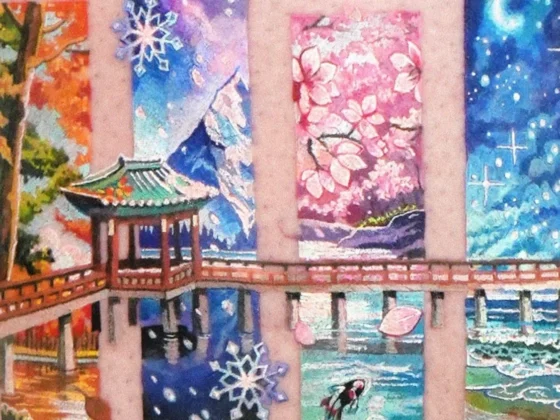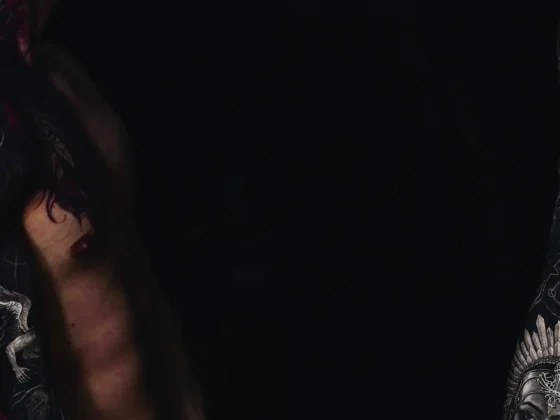Charlie Connell
June 23rd, 2021
Tattooing the Classics
Meet the artist who carves recreations of famous sculptures in marble, then adorns them with iconic tattoos.
From the Venus de Milo to Michelangelo’s David to the Winged Victory of Samothrace, all of the most famous classical sculptures have one thing in common—pristine, white marble. Any variation in the coloring of the marble can be distracting, so seeing a marble sculpture covered in Russian prison tattoos is downright jarring. Fabio Viale chisels recreations of famous sculptures in marble before infusing the porous stone with pigment, essentially tattooing the statues. We spoke with Viale about how he got into sculpture, why he chooses to juxtapose tattoos with classical art and more.
Do you remember the first time you fell in love with art? I was 12 when I saw Michelangelo’s Rondanini Pietà and Leonardo’s “Last Supper” on the same day. I don’t think I understood, but I certainly heard.
Growing up in Italy, you were likely exposed to a ton of classical art. Can you tell us what it was like growing up in that environment?
You get used to beautiful things to the point of not seeing them anymore. I realized the difficulty and depth needed to create similar works when I decided to reproduce the great classics. Technical skill is not enough, it is just a mental process.

When did you know you wanted to become an artist? At the age of 14, when I enrolled in art high school and saw Sinéad O’Connor’s video for “Nothing Compares 2 U.” Kids will grow up doodling or painting with watercolors, but sculpture seems like a much more difficult medium to break into. How did you find your way to sculpture? Fortunately, I discovered my talent at 16. I sculpted a hand in marble that touched the intimacy of a woman and when I finished it the professor said to me, “When you grow up you will be a sculptor.” So it went. How did you become interested in tattoo art?
I have always considered the tattoo as a form of decoration, then I met a Russian with tattooed hands. Since that day I have decided to use the criminal tattoo on classic statues.

When did you know you could combine tattoo design into sculpture?
I inherited some pigments to dye marble from an old sculptor with whom I shared the studio. Because marble is porous like paper, it absorbs color. I imagined a life-size version of Michelangelo’s David, fully tattooed with Russian criminal tattoos. I hope one day I can do it. Can you tell us about the process you use to create those tattooed sculptures, because it doesn’t appear as if the designs are simply painted upon them.
I have used several techniques in collaboration with well-known restorers and chemical centers, but the process I use is simply based on the penetration of the pigment into the first millimeter of the surface. The difficulty is being able to fix it as if on the skin.

Your “Truly” show must have been a massive undertaking to put together. Can you shed some light as to how that all came together?
Every year Pietrasanta—a city famous for its artistic marble workshops because it is close to the Carrara marble quarries—hosts a large personal exhibition to a master of contemporary art. When I went to Pietrasanta for the first time at the age of 20 and saw the Fernando Botero exhibition, I wondered if I too would be able to have an exhibition in that square when I grew up. Seeing my little girls running in the square among my sculptures was one of the greatest joys of my life. Why do you think the juxtaposition of tattoo art and classical sculpture works so well, particularly when they are on display throughout the Piazza del Duomo?
The Pietrasanta exhibition staged a curious mechanism. Once in the churches were painted pictures depicting crucifixes with destroyed pagan statues on the ground to symbolize the triumph of Christianity. In this square, with two important churches, everyone photographed the (pagan) sculptures and the church in the background. Interesting dynamics, a mirror of the times. You seem to be particularly interested in the style of tattoos seen throughout the Russian criminal underground. What drew you to these in particular?
I am interested in the symbolic tattoo, I am not attracted to decorative forms. I see in the criminal tattoo a sort of aesthetic ignorance that draws all the viewer’s attention to the contents.

Where do you see your art going in the future?
I’ve always had the need to change my ways of expression. But I’m getting old… We’ve seen how tattoos have influenced your art, do you have any tattoos of your own?
I don’t have one, but the worst thing is that I’ve never wanted one.
Editor's Picks
Royal & The Serpent
The hilarious and talented musician talks mental health, music, tattoos and more
Son of a Sinner
From rough-and-tumble roots to mainstream stardom, this genre-crossing musician is on a roll
A Cut Above
Celebrated barber Vic Blends can charge whatever he wants for a haircut, but all he really wants in exchange is a conversation and human connection














